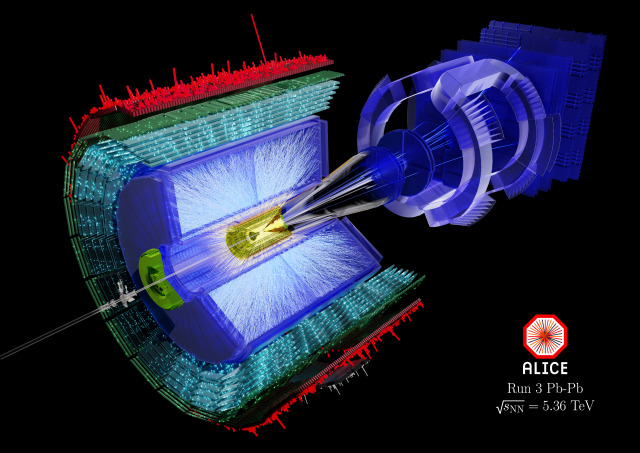research
A selection of my research interests.
Overview

As a researcher in high-energy particle physics, I am mainly involved in the analysis of data provided by the ALICE experiment. The ALICE experiment is one of the four major experiments at the Large Hadron Collider (LHC), with special focus on heavy-ion collisions. While the LHC normally provides collisions of two protons (pp collisions), a fraction of each years datataking is dedicated to the collision of heavy-ions such as lead (Pb-Pb collisions), as well as asymemetric collisions of protons and lead ions (p-Pb collisions). This data offers especially interesting physics insights inaccessible with mere pp collision, that either arise due to so-called cold nuclear matter effects or the formation of a new state of matter: The Quark-Gluon Plasma (QGP). I am particularly interested in the following research questions, which are connected to my various research projects given in this section:
- How does the substructure of a proton change when part of a bigger structure, e.g. a lead nucleus?
- What are the probability distributions of very soft (low momentum) gluons inside the proton? Can we probe the onset of non-linear Quantum Chromodynamics (QCD), i.e. gluon saturation?
- How do outgoing quarks of a hard scattering process fragment into heavy neutral mesons such as omega mesons? Is our theoretical description of their production accurate?
- Quantification of transport properties of the Quark-Gluon Plasma (QGP). How does the QGP modify the production of various observables such as jets?
Over the years I became increasingly more interested in tackling these questions using electromagnetic probes, especially prompt photons. Prompt photons are produced directly in the hard scattering of quarks and gluons, and do not interact strongly in the subsequent evolution of the collision. This makes them a particularly robust probe for constraining Parton Distribution Functions (PDFs) and testing perturbative QCD (pQCD). Their measurement in nuclear environments allows disentangling cold nuclear matter effects from possible modifications from a hot QCD medium and provide constrains for nuclear PDFs.
Measuring photons and other electromagnetic probes requires special detectors that measure their energy: Calorimeters. As member of the ALICE collaboration, I am particularly involved in the following sub-detectors of ALICE:
- the Electromagnetic Calorimeter (EMCal): A lead-scintillator sampling calorimeter operational in ALICE since 2010.
- the Forward Calorimeter (FoCal): A future upgrade to the ALICE experiment that allows to measure electromagnetic probes at very forward rapidities, planned to be operational in ~2029
Research efforts
In particular, my ongoing research efforts are:
- Measurement of isolated prompt photon production in small and large collision systems with ALICE to study the initial state of heavy-ion collisions
- Measuring the correlation of photons and jets produced in Pb-Pb collisions to learn about the QGP
- Detailed simulation studies for the future Forward Calorimeter (FoCal), especially estimates on the performance of prompt photon reconstruction and potential physics impact, especially in the light of ongoing searches for gluon saturation.
- Measuring omega meson production in pp collisions to improve our understanding of vector meson fragmentation
- Using Bayesian inference on a vast amount of heavy-ion data in order to systematically and rigorously study the QGP. This work is carried out as part of the JETSCAPE collaboration.
Feel free to have a look at my publications and talks for further information.
Outreach & more
I currently serve as ALICE Junior Representative, which represents the interests junior members (<5 years after PhD) in the collaboration. As representative, I participate in the Management Board and Collaboration Board of the ALICE collaboration. I also give guided tours of the ALICE experiment for interested friends & the public. I also participated in a previous edition of the ALICE Masterclass, which teaches students about what we do here at the LHC.